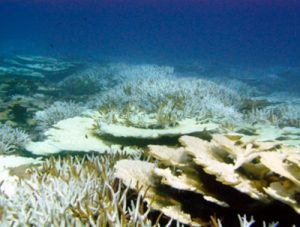28 August 2017
Biodegradable microbeads may clean sunblock chemical from seawater
Posted by Lauren Lipuma

Coral bleaching at Howland in the Pacific Remote Island Areas. Scientists say a new type of microbead can pull a coral-killing sunscreen ingredient from ocean water.
Credit Bernardo Vargas-Ángel/NOAA.
By Madeleine Jepsen
Beach-goers around the world who slather on sunblock before an ocean swim can unwittingly contribute to coral-reef bleaching. Oxybenzone, a chemical in many types of sunblock and some hair products, can cause coral bleaching and death by damaging the coral’s genetic material, according to researchers.
A team of scientists has proposed a new way to remove oxybenzone from the ocean by using tiny, absorbent beads to soak up the chemical. The biodegradable beads, made of algae- and crustacean-based compounds, also contain a core of magnetite, which allows the beads to be removed from the water with a magnet after they’ve absorbed the harmful oxybenzone. The magnetite, a type of iron oxide, also occurs naturally in igneous and metamorphic rocks. The research team presented their invention last week at the 254th National Meeting and Exposition of the American Chemical Society in Washington, D.C.
Although alternative sunblock compounds exist, many alternative chemicals are equally harmful for the environment, the researchers said. The beads would help prevent oxybenzone from harming nearby coral after the chemical leaches into seawater from a swimmer’s sunscreen.
“It’s a very simple and unique system of trying to protect these areas,” said Felix Román, an environmental chemist at the University of Puerto Rico in Mayaguez and the project’s lead researcher. “It’s not going to be possible to clean the whole ocean — that’s a very, very big task. But you can spread these microbeads around affected areas or where people bathe, and try to soak these harmful chemicals from the water.”
The researchers said in preliminary tests, the beads were found to soak up 95 percent of the oxybenzone within 60 minutes in an ocean water sample containing 30 parts per million of oxybenzone, or roughly 30 milligrams of oxybenzone per liter of seawater. While this is a small amount of oxybenzone, even a tiny fraction of this amount of oxybenzone has been shown to negatively impact coral, according to the researchers.
An estimated 20 percent of the world’s reefs are severely damaged and unlikely to recover, and about half of the remaining coral reefs are under risk of future collapse, according to the National Oceanic and Atmospheric Administration. Coral reefs support more species than any other marine ecosystem and rival rainforests in biodiversity, according to NOAA.
“We’re not talking about a species going to extinction, we’re talking about entire ecosystems capable of sustaining hundreds or maybe thousands of lives,” said Victor Fernandez, a graduate student at the University of Puerto Rico and member of the research team. “If we destroy an ecosystem, we’re going to destroy thousands of species.”
The researchers said they plan to conduct larger-scale tests of the beads in future work to determine how many of beads would be needed to absorb oxybenzone from a single swimmer’s sunscreen. After that, the researchers would be able to estimate how many beads would be needed to clean an entire beach or to protect vulnerable areas. Román said magnetic fields or a net full of the beads dragged behind a boat could be used to help remove contaminants from the water at a larger scale in future applications.
Future work may also include modifications to the surface of the beads, allowing them to absorb other pollutants such as oil derivatives from oil spills, according to the researchers. They said combinations of modified beads could also help filter out multiple pollutants from the water simultaneously.
“For scientific purposes, you don’t start with a broad range, you first have to start with one compound, then try another one, then mix all of them together,” Román said. “It’s a process, so we’re starting in that direction, and we’re starting with one of the most concern … but we are going to be targeting a wider range of pollutants.”
— Madeleine Jepsen is a science writing intern at AGU.










 GeoSpace is a blog on Earth and space science, managed by AGU’s Public Information staff. The blog features posts by AGU writers and guest contributors on all sorts of relevant science topics, but with a focus on new research and geo and space sciences-related stories that are currently in the news.
GeoSpace is a blog on Earth and space science, managed by AGU’s Public Information staff. The blog features posts by AGU writers and guest contributors on all sorts of relevant science topics, but with a focus on new research and geo and space sciences-related stories that are currently in the news.
How can you destroy oxybenzone ?